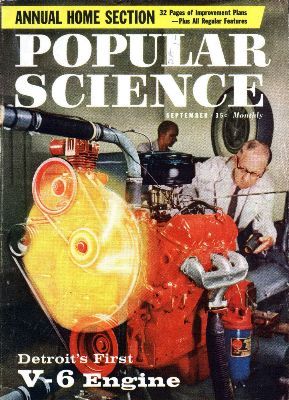

September 1959 --- By Ken Fermoyle

"Check the water & oil?" I nodded yes & the gas-station attendant raised the
hood of a GMC Suburban heavy-duty station wagon. He glanced at the engine,
then did a fast double-take.
He counted, " . . . four, five six," then scratched his head in amazement.
"What's this? A V8 with only six spark plugs!?"
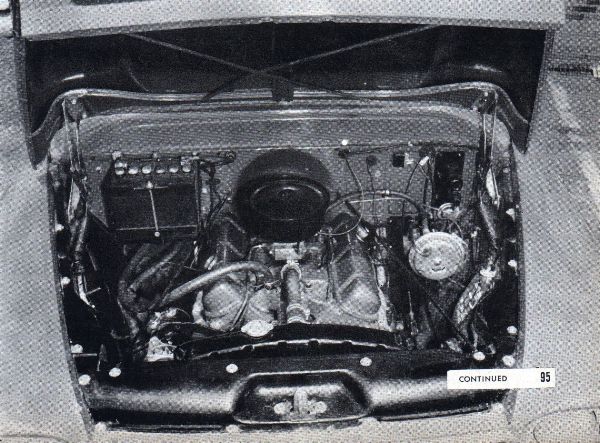
Not quite. Masked in the dowdy wagon was an exciting new V6, developed by GMC
Truck & Coach Division. A 60-degree V-type design, it will come in 6 & 12
cylinder versions. More important, it will mark the first time that Detroit
has brought a V6 out of experimental labs & offered it to paying customers.
Italy's Lancia has of course, had a V6 for years; & it's been an open secret
that both GM & Chrysler engineers have been tinkering with these
unorthodox power plants.
They're not in production yet --- the Suburban that GMC let me have was powered by
an experimental job. But you couldn't be blamed for guessing that they will soon
replace the V8 & inline six-cylinder gas engines that GMC now uses.
The new engine comes in four sizes. Three are V6s, displacing 305, 351, & 401 cubic
inches, the fourth is a whopping 702 cid V12 --- or twin-Six as it is called at GMC
headquarters. Gross horsepower ratings, not official yet, range from 150@ 3600 rpm
for one version of the 305 engine to 275 @ 2500 rpm for the big V12.
For the truck driver, the muscular torque curves of the new engines promise a lot less
work with the shift lever. For the general motorist, they promise less frustration
behind crawling trucks.
How do these power plants compare with conventional truck engines? They don't, according
to Phil Monaghan, GMC's boss. "Not only do they differ in design, they're far superior
to existing engines. They have a potential of between 100,000 to 200,000 miles of
continuous operation without major overhaul."
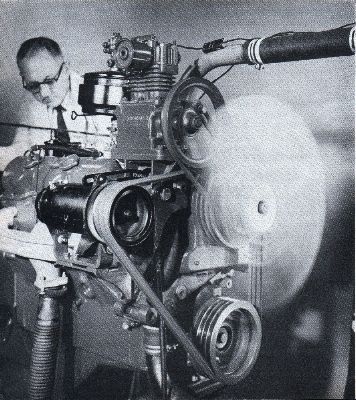
Cylinders in 60-degree bank produce their greatest power at 1100 fewer rpm then a V8.
Other advantages include:
Compact size; shorter then inline engines, narrower then V8s
Excellent performance; tremendous low-speed torque & plenty of reserve power
Superior fuel economy on regular gas, due to low friction & high combustion efficiency
High degree of parts interchangeability
Easy servicing; parts that need periodic attention are very accessible
Getting at the plugs is simplicity itself -- because they're on top, between the valve
covers. Deep crankcase extends well below the crankshaft centerline. The oil pan is big.
Crankshafts have four main bearings & six connecting-rod journals spaced 60 degrees apart.
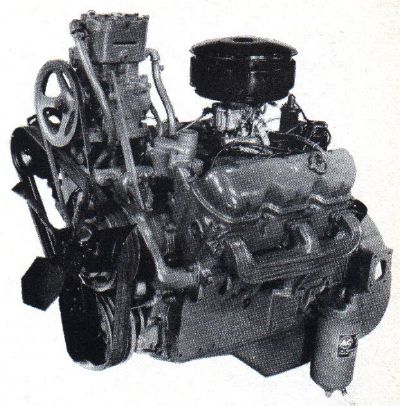
Some of these points showed up quickly in the experimental
Suburban that GMC proudly turned over to me.
"Do whatever you like with it," said Monaghan, "but remember that this is strictly a 1959
model except for the engine. It won't give you the full picture of how good vehicles
specially tailored for these engine can be."
A run through traffic from Pontiac to Detroit was my first experience behind the 150-hp
305-cid engine. Although the engine was tight, it jumped the heavy wagon away from lights
at a rate that surprised me. The V6 also pulled very smoothly from low speeds in high gear.
I could drop below 15 mph & still accelerate quickly & easily in high --- something that
conventional sixes don't do happily.
Next day I checked fuel milage in rush-hour traffic. I spent several hours driving the type
of stop-start pattern the engine would encounter in delivery or pickup service. I didn't
baby the Suburban. It's acceleration was used freely in getting away from lights & taking
advantages of holes in traffic. Then came a stint on expressways, running at legal limits of
55 & 65 mph. In the afternoon it was back to crosstown shift-change traffic of bumper-to-bumper
variety. I expected an average of 11-12 mpg. I got 15.5. all this despite a rugged
gas-drinking driving schedule, & an engine with less than 800 miles on it.
Easy servicing will be a strong point of these new engines. The gas-station attendant
mentioned earlier, after he recovered from his confusion, agreed.
The spark plugs caught his eye because they're right on top of the engine. "Man, those sure
will be easy to change!" said the gas-station man enthusiastically---doubtless remembering
wrists burned by hot exhaust manifolds on typical V8s. Cooler operation, because they're
well away from exhaust heat, won't hurt plug life, either.
The fuel pump is conveniently located at top right of the engine front cover. Starter motor,
oil filler cap & dip stick & generator are on the right. Distributor & coil are mounted
at top rear between the cylinder banks.
Valve tappets can be removed through an opening in the cylinder head without
removing the head, a real time saver.
Not so apparent are features that, prolonged dynamometer testing indicates, will give the
new engines as much as three to four times the durability of existing engine.
Blocks & heads are fine-grain nickel-chromium alloy iron.
Blocks have deep three-inch skirts for reinforcement.
All are over-square, have bigger bore than stroke for reduced friction.
Crankshafts are heavy, rugged. The 401 V6 shaft, for example, weighs 110 lbs vs 63 lbs
for a comparable V8 shaft. V6s have four main bearing; the V12, seven.
Lubrication is excellent; rotor-type oil pumps supply more oil at greater pressure than
ordinary gear-type pumps.
Areas of high stress have oversized section to minimize flexing. Generous fillets & web
reinforcements add strength & rigidity to moving parts.
Careful attention to engine cooling eliminates wear-producing hot spots.
This last factor is particularly important in producing long-lived engines. Two to three
times more coolant flows through the new powerplants than in engines of previous design.
Bores are surrounded by wide water channels for their full height. To overcome short life
expectancy usual in truck-engines valves & valve seats due to lack of proper heat
transfer, coolant is circulated through cylinder heads at the rate of 120 to 200 gallons per
minute --- enough to fill a 12-by-27-foot swimming pool in an hour.
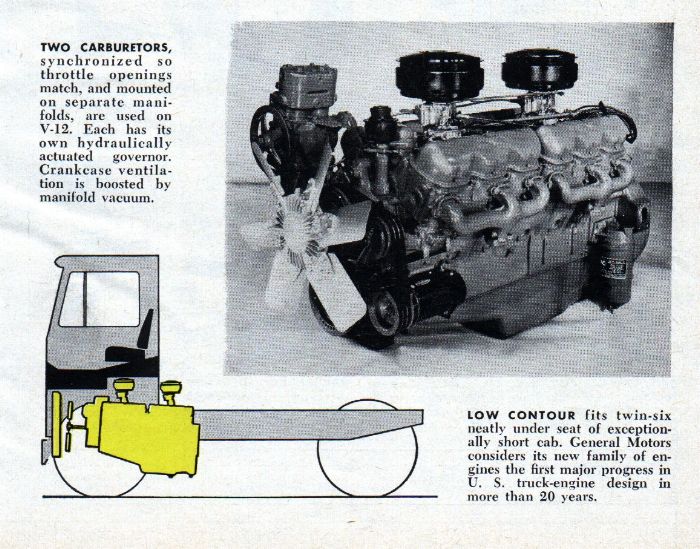
Stroke for all four engines is 3.58 inches. The 305 has a bore 4.25 inches; the 351, 4.56
inches; the 401, 4.88 inches. The V12 bore is 4.65 inches, same as the 351 V6.
Similarity of bore size between the 351 V6 & the 702 V12 is a tipoff to the general
interchangeability of engine. No less than 70 parts are common to all V6s & more than 50
are common to all V6s & the V12 too. Just two different types of cylinder heads era
needed for the entire line, for example --- one for 305 engines & the other for the two
bigger V6s & the V12. They just double up, use four head instead of two on the V12.&
it's block actually is run down the same line as the V6s; drilling machines make two passes
instead of one to bore out cylinders.
The engine is smooth. Judging from my experience, GMC has licked the imbalance problem
chronically associated with V6 engines. I had asked Monaghan about this before driving
the Suburban.
"That has caused us no difficulty," he said. "We engineered them to minimize imbalance as
much as possible. Remember, too, these engines have been designed as truck power plants.
There is a lot more structure & built-in rigidity in them to soak up vibration then would
be possible in automobile engines.'
I wouldn't have been able to tell there was a V6 & not a V8 under the hood if I hadn't
known in advance. The engine churned without undue shake. There must be some
secondary imbalance present, but it doesn't show. It was quiet enough so that maybe
Monaghan wasn't kidding with his comment that they might "build a little more noise back
into it just to let people know it's working!"
One thing that obviously helps here is that combustion chambers --- formed partly in the
head & partly cut into the piston top --- are fully machined. This insures uniform
compression ratios between cylinders & eliminates power impulses common in simple
cast chambers which often have varying ratios.
High-turbulence combustion-chamber design is also an important factor in the excellent
low-speed torque of these engines. The design causes rapid burning of fuel-air charge early
in the power stroke, giving the piston a firm "push" through it's full trip down the cylinder.
Low-speed torque of the huge V12 is especially impressive. It's maximum gross torque of
630 lb-ft is developed from 1600 to 1900 rpm --- & it is not vary far from that maximum
over a considerably wider engine speed range. The great reserve power will permit use of
five speed transmissions in big tractor-trailer units in place of the usual eight or ten speed
transmission. The V12's ample power will haul trucks up grades at good speed with a
minimum of downshifting, & without holding up long lines of motorists behind.
Return to The 6066 GMC Trucks Memorabilia Page.
~ 6066 GMC Trucks ~ 6066 GMC Trucks ~ 6066 GMC Trucks ~ 6066 GMC Trucks ~ 6066 GMC Trucks ~ 6066 GMC Trucks ~ 6066 GMC Trucks ~ 6066 GMC Trucks ~
© WebPage Design, 2000-2006 6066 GMC Trucks.
© Artical & Photos, 1959 Popular Science.
Last Updated January 1, 2006.